NO RESERVE 1967 FORD MUSTANG FASTBACK 5 SPEED CLEAN TURNS HEADS UPGRADES NICE 1
- Make: Ford
- Model: Mustang
- SubModel: FAST FUN PONY 289 PEARL WHITE
- Type: Fastback
- Trim: FASTBACK
- Year: 1967
- Mileage: 13276
- VIN: 7T021200637
- Color: WHITE
- Engine size: 289
- Number of cylinders: 8
- Fuel: Gasoline
- Transmission: Manual
- Drive type: RWD
- Interior color: RED
- Drive side: Left-hand drive
- Options: CD Player
- Vehicle Title: Clear
- Location: Wheat Ridge, Colorado, United States
Description
1967 FORD MUSTANG FAST BACK CLEAN MANY UPGRADES FRONT DISK BRAKES REAR SWAY LINKS. BORG AND WARNER 5SPEED TRANSMISSION DUAL EXHAUST CROSS OVER NEW PLUGS ELECTRONIC FUEL PUMP AND HOLLY 4 BARREL CARB. WE SUGGEST ITS A 427 CID ENGINE. RUNS GREAT ON THE HIGHWAY KEEPS COOL NO HEAT UP. INTERIOR IN FANTASTIC SHAPE THE VIN CODES MATCH EVERYTHING EXCEPT THE ENGINE AND 5 SPEED TRANSMISSION.CALL ANY TIME FOR INFO 303-425-8707 DOES NOT HAVE NUMBERS MATCHING MOTOR OR TRANSMISSION.
1967–1968
The 1967 model year Mustang was the first redesign of the original model. Ford's designers began drawing up a larger version even as the original was achieving sales success, and while "Iacocca later complained about the Mustang's growth, he did oversee the redesign for 1967 ."[40] The major mechanical feature was to allow the installation of a big-block V8 engine. The overall size, interior and cargo space were increased. Exterior trim changes included concave taillights, side scoop (1967 model) and chrome (1968 model) side ornamentation, square rear-view mirrors, and usual yearly wheel and gas cap changes. The high-performance 289 option was placed behind the newer 335hp (250kW; 340PS) 390cuin (6.4L) FE engine from the Ford Thunderbird, which was equipped with a four-barrel carburetor. During the mid-1968 model year, a drag racer for the street could be ordered with the optional 428cuin (7.0L) Cobra Jet engine which was officially rated at 335hp (250kW; 340PS) all of these Mustangs were issued R codes on their VINs.[41]
The 1967 Deluxe Interior was revised, discontinuing the embossed running horse motif on the seat backs (the source for the "pony interior" nickname) in favor of a new deluxe interior package, which included special color options, brushed aluminum (from August 1966 production) or woodgrain dash trim, seat buttons, and special door panels. The hardtop also included upholstered quarter trim panels, a carryover from the 1965–1966 deluxe interior. The 1967 hardtop also had the chrome quarter trim caps, carried over from 1965–1966, but these were painted to match the interior in 1968 models. The 1967 deluxe interior included stainless steel-trimmed seat back shells, similar to those in the Thunderbird. These were dropped at the end of the 1967 model year, and were not included in the woodgrain-trimmed 1968 interior. The deluxe steering wheel, which had been included in the deluxe interior for the 1965–1966, became optional, and could also be ordered with the standard interior. The 1968 models that were produced from January 1968 were also the first model year to incorporate three-point lap and shoulder belts (which had previously been optional, in 1967–1968 models) as opposed to the standard lap belts. The air-conditioning option was fully integrated into the dash, the speakers and stereo were upgraded, and unique center and overhead consoles were options. The fastback model offered the option of a rear fold-down seat, and the convertible was available with folding glass windows. Gone was the Rally-Pac, since the new instrument cluster had provisions for an optional tachometer and clock. Its size and shape also precluded the installation of the accessory atop the steering column.[42] The convenience group with four warning lights for low fuel, seat belt reminder, parking brake not released, and door ajar were added to the instrument panel, or, if one ordered the optional console and A/C, the lights were mounted on the console.[43]
Changes for the 1968 model increased safety with a two-spoke energy-absorbing steering wheel, along with newly introduced shoulder belts. Other changes included front and rear side markers, "FORD" lettering removed from hood, rearview mirror moved from frame to windshield, a 302cuin (4.9L) V8 engine was now available, and C-Stripe graphics were added.[44]
The California Special Mustang, or GT/CS, was visually based on the Shelby model and was only sold in Western states. Its sister, the 'High Country Special', was sold in Denver, Colorado. While the GT/CS was only available as a coupe, the 'High Country Special' model was available in fastback and convertible configurations during the 1966 and 1967 model years, and as a coupe for 1968.[41]
The 1968 Ford Mustang GT Fastback reached iconic status after it was featured in the 1968 film Bullitt, starring Steve McQueen.[45] In the film, McQueen drove a modified 1968 Mustang GT 2+2 Fastback chasing a Dodge Charger through the streets of San Francisco.[46]
-
1968 Fastback with side marker visible
-
Convertible
-
1967 Shelby
-
1968 Shelby GT350
-
Mustang GT/CS
-
1968 Mustang High County Special
-
1967–1968 front end style comparison
-
1968 Mustang fastback from the "Bullitt" movie at the 2018 Geneva Motor Show
| 1968 Ford Mustang hardtop | ||||
| August 1966 – August 1968[37] | ||||
| Dearborn, Michigan San Jose, California Metuchen, New Jersey Valencia, Venezuela Mexico City, Mexico[1][2] Lima, Peru | ||||
| Ross Humphries (1965) | ||||
| 2-door hardtop 2-door fastback 2-door convertible | ||||
| 200cuin (3.3L) Thriftpower I6 260cuin (4.3L) Windsor V8 289cuin (4.7L) Windsor V8 289cuin (4.7L) Windsor HiPo V8 302cuin (4.9L) Windsor V8 390cuin (6.4L) FE V8 427cuin (7.0L) FE HiPo* V8 428cuin (7.0L) Cobra Jet V8[38] | ||||
| 3-speed manual 4-speed manual 3-speed automatic | ||||
| 108in (2,743mm) | ||||
| 183.6in (4,663mm) | ||||
| 70.9in (1,801mm) | ||||
| 51.6in (1,311mm) | ||||
| 2,758lb (1,251kg) (base)[39] | ||||
| 200cuin (3.3L) Thriftpower I6 | 1968 | 1-barrel | 115bhp (86kW; 117PS) @ 4,400 | 190lb⋅ft (258N⋅m) @ 2,400 |
| 1967 | 120bhp (89kW; 122PS) @ 4,400 | |||
| 289cuin (4.7L) Windsor V8 | 1968 | 2-barrel | 195bhp (145kW; 198PS) @ 4,600 | 288lb⋅ft (390N⋅m) @ 2,600 |
| 1967 | 200bhp (149kW; 203PS) @ 4,400 | 282lb⋅ft (382N⋅m) @ 2,400 | ||
| 302cuin (4.9L) Windsor V8 | 1968 | 210bhp (157kW; 213PS) @ 4,600 | 300lb⋅ft (407N⋅m) @ 2,600 | |
| 289cuin (4.7L) Windsor V8 | 1967 | 4-barrel | 225bhp (168kW; 228PS) @ 4,800 | 305lb⋅ft (414N⋅m) @ 3,200 |
| 302cuin (4.9L) Windsor V8 | 1968 | 230bhp (172kW; 233PS) @ 4,800 | 310lb⋅ft (420N⋅m) @ 2,800 | |
| 289cuin (4.7L) Windsor HiPo V8 | 1967 | 271bhp (202kW; 275PS) @ 6,000 | 312lb⋅ft (423N⋅m) @ 3,400 | |
| 390cuin (6.4L) FE V8 | 1968 | 2-barrel | 270bhp (201kW; 274PS) @ 4,400 | 401lb⋅ft (544N⋅m) @ 2,600 |
| 1967 | 4-barrel | 320bhp (239kW; 324PS) @ 4,800 | 427lb⋅ft (579N⋅m) @ 3,200 | |
| 1968 | 325bhp (242kW; 330PS) @ 4,800 | |||
| 1969 | 320bhp (239kW; 324PS) @ 4,600 | |||
| 428cuin (7.0L) Cobra Jet V8 | 1968 | 335bhp (250kW; 340PS) @ 5,200 | 440lb⋅ft (597N⋅m) @ 3,400 | |
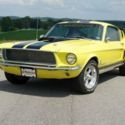 1967 Mustang Fastback 289 V8 4-Speed Toploader w/ Shelby Upgrades
1967 Mustang Fastback 289 V8 4-Speed Toploader w/ Shelby Upgrades
Mileage: 22395
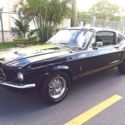 RARE 1967 FORD MUSTANG FASTBACK "A" CODE, SHELBY GT350 LOOK, NICE, NO RESERVE!!!
RARE 1967 FORD MUSTANG FASTBACK "A" CODE, SHELBY GT350 LOOK, NICE, NO RESERVE!!!
Mileage: 100,029
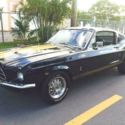 RARE 1967 FORD MUSTANG "A" CODE FASTBACK! NUMBERS MATCH, AUTO, NICE, LO RESERVE
RARE 1967 FORD MUSTANG "A" CODE FASTBACK! NUMBERS MATCH, AUTO, NICE, LO RESERVE
Mileage: 102112
 1967 Ford Mustang Fastback 289 5 Speed Disc Brakes Very Nice Car Many New Parts!
1967 Ford Mustang Fastback 289 5 Speed Disc Brakes Very Nice Car Many New Parts!
Mileage: 19,670
 1967 Ford Mustang Fastback S Code 390 GT 4 Speed Deluxe Interior Very Nice
1967 Ford Mustang Fastback S Code 390 GT 4 Speed Deluxe Interior Very Nice
Mileage: 19,670
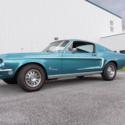 1968 Ford Mustang fastback J Code Built Heads similar to 1967 1966 1965 1969 she
1968 Ford Mustang fastback J Code Built Heads similar to 1967 1966 1965 1969 she
Mileage: 15000
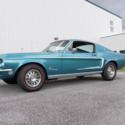 1968 Ford Mustang fastback J Code Built Heads similar to 1967 1966 1965 1969 S
1968 Ford Mustang fastback J Code Built Heads similar to 1967 1966 1965 1969 S
Mileage: 15000
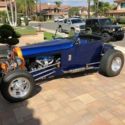 NO RESERVE...EXTREMELY DETAILED CUSTOM BUILD, VERY FAST, TURNS HEADS EVERYWHERE
NO RESERVE...EXTREMELY DETAILED CUSTOM BUILD, VERY FAST, TURNS HEADS EVERYWHERE
Mileage: 600
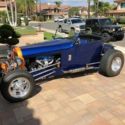 EXTREMELY DETAILED CUSTOM BUILD, VERY FAST, TURNS HEADS EVERYWHERE NO RESERVE
EXTREMELY DETAILED CUSTOM BUILD, VERY FAST, TURNS HEADS EVERYWHERE NO RESERVE
Mileage: 600
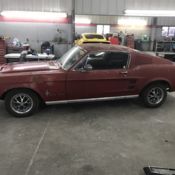 1967 FORD MUSTANG FASTBACK S CODE 390GT Engine 4 SPEED 9" Rear Red on Black NICE
1967 FORD MUSTANG FASTBACK S CODE 390GT Engine 4 SPEED 9" Rear Red on Black NICE
Mileage: 196,700












